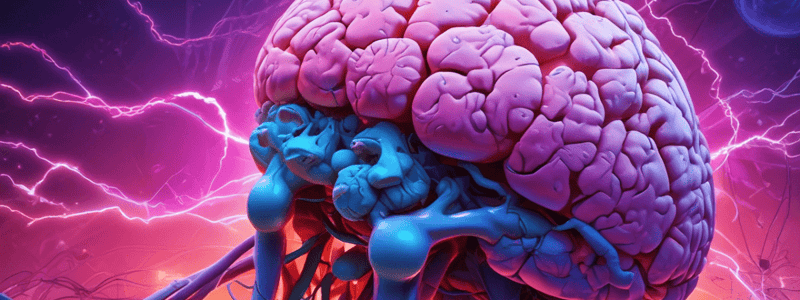Podcast
Questions and Answers
What type of epilepsy includes absence, myoclonic, atonic, tonic, and tonic–clonic seizures?
What type of epilepsy includes absence, myoclonic, atonic, tonic, and tonic–clonic seizures?
- Focal aware seizures
- Bilateral tonic–clonic epilepsy
- Focal non-motor seizures
- Generalized epilepsy (correct)
Which phase temporarily suppresses neuronal activity in the affected area?
Which phase temporarily suppresses neuronal activity in the affected area?
- Hyperpolarization (correct)
- Synchronous Discharges
- Shortened Hyperpolarization
- Interictal Activity
What arises from a group of neurons firing together before a seizure occurs?
What arises from a group of neurons firing together before a seizure occurs?
- Hyperpolarization
- Shortened Hyperpolarization
- Synchronous Discharges
- Interictal Activity (correct)
Which type of seizures are characterized by a depolarizing shift in the membrane potential of neurons?
Which type of seizures are characterized by a depolarizing shift in the membrane potential of neurons?
What happens if a sufficient number of neurons become activated and the inhibition from local inhibitory interneurons is overcome?
What happens if a sufficient number of neurons become activated and the inhibition from local inhibitory interneurons is overcome?
During which phase does the period of hyperpolarization become shorter, leading to further depolarization of neurons?
During which phase does the period of hyperpolarization become shorter, leading to further depolarization of neurons?
What is the most common surgical operation for refractory patients with epilepsy?
What is the most common surgical operation for refractory patients with epilepsy?
Which of the following medications inhibits a spike generating Ca2+ current in thalamic neurones?
Which of the following medications inhibits a spike generating Ca2+ current in thalamic neurones?
What proportion of refractory patients benefit from a surgical approach if an underlying structural lesion is identified?
What proportion of refractory patients benefit from a surgical approach if an underlying structural lesion is identified?
What is the chance of a patient being seizure-free after a temporal lobe resection surgery?
What is the chance of a patient being seizure-free after a temporal lobe resection surgery?
Which research article provides a practical clinical definition of epilepsy?
Which research article provides a practical clinical definition of epilepsy?
Who published 'Essential Med Notes 2020 Comprehensive Medical Reference & Review'?
Who published 'Essential Med Notes 2020 Comprehensive Medical Reference & Review'?
What is a seizure?
What is a seizure?
Which of the following can be a cause of a seizure?
Which of the following can be a cause of a seizure?
According to the International League Against Epilepsy (ILAE) and the International Bureau for Epilepsy (IBE), how should epilepsy be considered?
According to the International League Against Epilepsy (ILAE) and the International Bureau for Epilepsy (IBE), how should epilepsy be considered?
What is a reflex seizure?
What is a reflex seizure?
After a single unprovoked seizure, what is the risk of having another seizure?
After a single unprovoked seizure, what is the risk of having another seizure?
If a person has two unprovoked, non-febrile seizures, what is the chance of having another seizure within 4 years?
If a person has two unprovoked, non-febrile seizures, what is the chance of having another seizure within 4 years?
How long must a person be seizure-free to be considered as having resolved epilepsy?
How long must a person be seizure-free to be considered as having resolved epilepsy?
What is the key clinical tool in evaluating an individual presenting with seizures?
What is the key clinical tool in evaluating an individual presenting with seizures?
Which of the following does the epilepsy classification framework help in understanding?
Which of the following does the epilepsy classification framework help in understanding?
What studies are taken into account when classifying seizure type and epilepsy type?
What studies are taken into account when classifying seizure type and epilepsy type?
What are the three levels of the new Classification of the Epilepsies based on available resources?
What are the three levels of the new Classification of the Epilepsies based on available resources?
What types of epilepsies are included in the focal epilepsies category?
What types of epilepsies are included in the focal epilepsies category?
What is the primary inhibitory neurotransmitter that helps regulate neuronal excitability during a seizure?
What is the primary inhibitory neurotransmitter that helps regulate neuronal excitability during a seizure?
Which of the following is NOT a common automatism observed during a seizure?
Which of the following is NOT a common automatism observed during a seizure?
Which type of seizure is characterized by whole-body muscle rigidity in flexion or extension?
Which type of seizure is characterized by whole-body muscle rigidity in flexion or extension?
What is the mechanism of action for anticonvulsant drugs like phenytoin, carbamazepine, valproate, and lamotrigine?
What is the mechanism of action for anticonvulsant drugs like phenytoin, carbamazepine, valproate, and lamotrigine?
Which type of seizure is characterized by whole-body repetitive rhythmic jerking movements?
Which type of seizure is characterized by whole-body repetitive rhythmic jerking movements?
Which of the following is NOT a characteristic of an absence (petit mal) seizure?
Which of the following is NOT a characteristic of an absence (petit mal) seizure?




